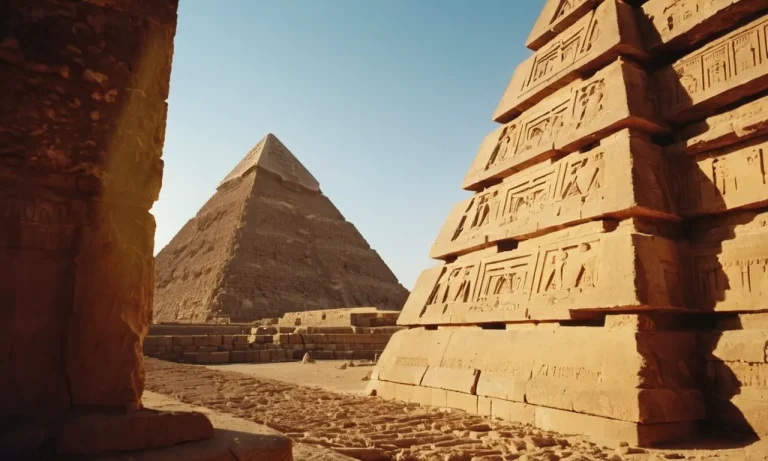The 10 plagues in Egypt recorded in the Bible are monumental events full of spiritual significance. If you’re pressed for time, here is the essence of the meaning behind these plagues: They reveal God’s supreme power over the gods and spirits of Egypt, declare His sovereignty over all creation, expose the futility of resisting His will, point to Christ as the final Passover sacrifice, and emphasize the need to free ourselves from sin’s enslavement.
In this comprehensive article, we will examine each plague inflicted upon Egypt in-depth to unpack the profound theological truths about the one true God encoded within these accounts.
The Backdrop of the 10 Plagues
Egyptian Polytheism and Nature Worship
The Egyptian religion centered around polytheism and nature worship. They worshipped up to 2,000 gods that controlled various aspects of nature such as the sun, the Nile River, childbirth, and more. Pharaohs were considered to be divine rulers that mediated between the gods and the people.
Many of the 10 plagues specifically targeted Egyptian gods and demonstrated Yahweh’s power over them.
Moses’ Demand to Pharaoh: “Let My People Go!”
God chose Moses to lead the Israelites out of slavery in Egypt. Moses approached Pharaoh multiple times, demanding boldly “Let my people go!” But each time Pharaoh stubbornly refused. So through ten intense judgments from God called the 10 plagues, Pharaoh finally relented.
The plagues systematically destroyed the Egyptians’ confidence in their gods and their leader Pharaoh.
God’s Purpose: To Establish His Supremacy
The main purpose of the 10 plagues was for Yahweh to prove to the Egyptians that He is the one true omnipotent God. The plagues revealed His absolute control over nature, the idol gods of Egypt, and pharaoh himself.
After witnessing God’s undeniable power, the Egyptians came to fear and respect the God of the Israelites. Even Pharaoh was forced to acknowledge, “The LORD is in the right, and I and my people are in the wrong” (Exodus 9:27).
Plague #1 – Waters Turned to Blood
Attack on Egyptian River Gods
The first plague, turning the Nile River and other waters to blood, was a direct affront to Egyptian gods like Hapi, the god of the Nile, and Khnum, the ram-headed god said to control the Nile’s flooding.
By turning their sacred waters blood-red, God powerfully showed His superiority over these false Egyptian deities who were Lifeless and powerless in the face of God’s authority (Exodus 7:14-25).
Life is in the Blood
In the Biblical worldview, the life of every creature is in its blood (Leviticus 17:11). Therefore, by turning their water sources to blood, God struck at the heart of Egyptian life and health. The fish died, the river stank, they could not drink its water, and undoubtedly disease spread with contaminated water flooding the land (Exodus 7:21).
God can bring life or death through his control over nature.
This forced the Egyptians to dig for water around the Nile, experiencing intense thirst and deprivation. God was demonstrating His authority to create scarcity or abundance of natural resources at will.
Contamination of Life Source
Not only was Egypt’s water supply contaminated, but the Nile itself was sacred to them. The annual flooding of the Nile River sustained Egyptian agriculture, society, and economy. As the longest river in the world, it was crucial to ancient Egypt’s founding as a civilization.
By defiling their major water source, God attacked something fundamental. This would have been incredibly disturbing emotionally and spiritually for the Egyptians who relied on the Nile. God can tear down in an instant what man regards as enduring icons of stability.
Plague #2 – Frogs
Infestation of Hopping gods
The plague of frogs was deeply symbolic for the Egyptians, as frogs were associated with the goddess Heket. She was depicted as a woman with a frog’s head and represented life and fertility. Frogs were even considered sacred animals.
Yet suddenly these symbols of life and prosperity became a curse, overrunning Egypt in astounding numbers.
For the Israelites, it showed that the Egyptian gods were powerless before Yahweh, the one true God. Though frogs represented life and fruitfulness for Egypt, through this plague Yahweh demonstrated that He could turn their cherished goddesses against them and override the natural order.
It foreshadowed that the Lord would eventually triumph over the hardness of Pharaoh’s heart.
Overrun by Unclean Creatures
Not only would the frogs have been a religious affront, but also a physical nuisance. These unclean creatures would have contaminated food and drinking water, overrun beds and ovens, and made daily life miserable.
The contrast was clear: while the Israelites enjoyed relief in Goshen, the Egyptians suffered under the weight of uncleanliness and disorder brought by the hordes of frogs. Their cherished symbols of life had become loathsome pests.
Through it, God humbled the pride of Egypt before the Israelites headed for freedom.
Plague #3 – Gnats/Lice
Disempowering Egypt’s Priests
The third plague of gnats or lice held great spiritual significance in ancient Egypt. As scripture describes, this infestation of tiny insects came “out of the dust of the earth” after Aaron struck his staff on the ground (Exodus 8:16-17).
For the Egyptians, the dust held regenerative powers they associated with their god Geb. By bringing swarms of nasty bugs out of the revered dust, Yahweh demonstrated his complete power over Egypt’s gods.
The plague also specifically targeted and disempowered Egypt’s priests. Religious ritual cleanliness was vitally important in ancient Egypt. Priests shaved their entire bodies daily and wore only linen garments to prevent lice and maintain purity in temples.
The fact they could not stop or remove this plague would have undermined their authority and Status among Egyptians who looked to them for intercession with the gods.
Uncleanness Multiplied
On a deeper symbolic level, this plague represented the multiplication of uncleanness and suffering brought about by Egypt’s sinful oppression of God’s people. Scholars find significance in the plague emerging from the dust, which the Bible often associates with mourning, sorrow, humiliation, and death.
The imagery connects back to God’s curse after the fall where he warns Adam: “dust you are and to dust you will return” (Genesis 3:19).
The hardship and grief the Egyptians brought upon the Israelites was now being returned upon them in the form of pestilence springing from the dust itself. This pattern will continue through the remaining plagues, with Egypt’s sins producing an abundant “crop” of misfortune, pain, and loss.
| Plague | Spiritual Meaning |
|---|---|
| Bloodied Nile | Egyptian gods overpowered |
| Frogs | Fertility/resurrection corrupted |
| Gnats/Lice | Priests disempowered, uncleanness multiplied |
As the plagues intensify, Pharaoh’s arrogance and hard-heartedness toward God also becomes more evident. Yet this stubborn pride serves a spiritual purpose too – to make God’s glorious power and mercy shine all the brighter when the Israelites finally gain their freedom.
Plague #4 – Flies
Beelzebul – Lord of the Flies
In the Bible, the fourth plague God inflicted on Egypt was a swarm of flies (Exodus 8:20-32). Beelzebul, meaning “Lord of the Flies,” was a Canaanite god associated with flies and disease. The plague of flies was a direct assault on Beelzebul and the Egyptian belief system.
The flies invaded homes, palaces, and temples, contaminating food and bringing great distress and affliction. This demonstrated God’s supremacy over the so-called gods of Egypt. The plague was an act of divine judgment on the false Egyptian gods like Beelzebul that had kept the Israelites in bondage for 400 years (Genesis 15:13).
Pervasive Physical Discomfort
The plague of flies brought ubiquitous and inescapable torment, pain, and anguish. The flies corrupted the land with their swarming presence (Psalm 78:45). The flies ruined supplies of food and drink, making life unbearable.
Some key facts about the plague of flies:
- The flies came directly out of the desert sands, emerging from the insect underworld.
- The flies invaded all parts of Egyptian society, from Pharaoh’s palace to the lowliest hut.
- The flies spoiled food and drink by landing and crawling on it.
- The flies spread diseases like dysentery and ophthalmia.
The discomfort was so intense that even the magicians cried out “This is the finger of God!” (Exodus 8:19). Yet Pharaoh’s heart was hardened, refusing to yield to God’s demand to “Let my people go!” The flies afflicted all the Egyptians yet left the land of Goshen where the Israelites lived untouched, emphasizing God’s protective power.
Plague #5 – Death of Livestock
Economic Ruin through Animal gods
The fifth plague brought by God onto Egypt was the death of livestock, including horses, donkeys, camels, oxen, and sheep (Exodus 9:1-7). This plague was a direct attack on many of the animal gods the Egyptians worshipped, such as Apis the bull, Hathor the cow goddess, and Khnum the ram god.
By killing their livestock, God displayed his power over these false gods.
Livestock were more than just animals to the Egyptians – they represented wealth and status. The loss of their livestock was an economic catastrophe, destroying a key pillar of their society. Most Egyptians were involved in animal husbandry in some form, whether as herders or agricultural workers utilising oxen for ploughing and planting crops.
The death of livestock meant the loss of money, food, milk, clothing, and transportation.
Some key impacts of this plague:
- Severe financial loss – livestock were expensive capital assets
- Wiped out food production and agriculture – oxen were critical for ploughing fields
- Transport disruption – horses and camels provided key transport
- Lost income stream – milk, meat, hides and other products from livestock
- Undermined Egyptian social structure and belief system – animal gods central to their culture
This plague was a targeted attack on the heartbeat of the Egyptian economy. Despite the previous plagues, the Pharaoh still refused to let the Israelite slaves free. So God unleashed a plague that struck at the very foundation of their wealth and livelihood to demonstrate his sovereignty over Egypt.
Destroying Wealth and Sustenance
The death of Egypt’s vast numbers of cattle, horses, camels and other livestock in a single day had catastrophic effects:
- Famine and poverty due to destroyed food supply chains
- No milk or dairy products, eliminating an Egyptian staple food
- No meat, leather, hides or other animal products for income or trade
- Widespread unemployment for animal husbandry workers
- No beasts of burden for transport, farming, construction projects
- Loss of breeding stock for future animal populations
This decimation of Egypt’s livestock wealth underscores God’s message to Pharaoh about the supremacy of the Lord of Israel. Natural disasters or diseases would not strike with such speed and selectivity on purely livestock across all of Egypt.
This was a deliberate, targeted act by God to undermine the Egyptians’ prosperity, sustenance and transportation.
The economic impacts would have brought Egypt’s mighty empire to its knees. Trade slowed, construction projects halted, the food supply dwindled. Considering livestock’s vital role in their society, this plague represented a direct attack on Egyptian lifestyle and welfare for years to come.
It revealed the impotence of Egypt’s gods over Israel’s God and the hollowness of Pharaoh’s previous refusals to let the Israelites leave Egypt.
Yet despite these clear messages, Pharaoh stubbornly hardened his heart yet again after temporarily pleading to Moses to ask the Lord to remove this plague (Exodus 9:27-28). So God would continue demonstrating his sovereign power through furtherjudgements on Egypt.
Plague #6 – Boils
Affliction of Egyptian Deities
The sixth plague, that of festering boils, directly attacked multiple Egyptian gods who were connected to health, healing, and protection from disease (Exodus 9:8-12). In an astounding display of power, Yahweh inflicted Moses and Aaron to strike the dust of Egypt with their staffs, bringing painful, infectious boils on humans and animals alike across the land.
This plague displayed Yahweh’s authority over Imhotep, the god of medicine and healing, as well as Isis and Serapis, gods who were impotent to defend their people from such virulent pestilence. The complete helplessness and vulnerability felt by the Egyptians crushed their confidence in Egyptian deities.
The torturous pain from the agonizing skin eruptions wreaked physiological and psychological devastation everywhere in Egypt outside of Goshen where the Israelites lived. The physical torment was amplified by the unchecked spread and inescapability from contacting boils through dust particles ubiquitously present indoors and outdoors.
The epidemic scale overwhelmed the Egyptian magicians who were left as powerlessly afflicted as the commoners (Exodus 9:11). With no cure or remedy available, the impotence of Egypt’s gods and magic arts was laid bare.
Metaphorically, boils can represent painful sin having come to a head which requires the Divine Surgeon’s healing touch through applied atonement. Egypt was mired in idolatrous and evil practices, perhaps indicating a spiritual infection spreading through the land.
The boils externally manifested the deeper internal rot of rampant immorality which required painful lancing and purification.
Inescapable Pain and Suffering
The horror of the endemic infestation of excruciatingly painful, oozing skin ulcers unleashed an intensity of suffering difficult for us to fully grasp nowadays. Imagine unrelenting stinging torment razing through the body with no relief or way to assuage the misery.
Both humans and beasts across Egypt groaned in collective anguish under the boiling punishment except in the land of Goshen (Exodus 9:11).
The scale of affliction far exceeded any natural occurrence of skin disease cross-infecting livestock and humans. Rather, the Bible depicts a sobering scene of divine judgment meted out on an unprecedented scope.
There was no quarter given – nobles and peasants alike were reduced to the same level through indiscriminate suffering. By targeting visible skin surfaces, the humiliation and loss of personal dignity compounded the physical pain.
We also see in this plague the futility of merely treating surface symptoms rather than addressing root causes. Like lancing a boil to expel infectious material, Egypt was festering with deep-seated sins requiring painful purging for healing and spiritual restoration.
Yahweh alone could provide the cure through liberating the oppressed Israelites from slavery.
The boil epidemic foreshadowed the far greater agonies of hell that await unrepentant evildoers stored up through unforgiven wickedness (Psalm 11:6, Revelation 21:8). We serve a merciful and patient God slow to anger and rich in kindness (Exodus 34:6), yet judgment inevitability comes to those rejecting His salvation.
Plague #7 – Hail
Shattering Nut the Sky goddess
In ancient Egyptian mythology, Nut was the goddess of the sky. As the plague of devastating hail stormed down, the Egyptians would have seen their supposed sky goddess unable to stop the destructive frozen rain.
Nut was pictured as a woman arched over the earth, her star-filled body representing the heavens. But despite her status as a powerful goddess, Nut was helpless against the dramatic shattering hail pounding Egypt.
This would have seriously damaged the Egyptians’ confidence in Nut’s power and protection.
The crushing hail was a dramatic demonstration that the God of Israel was mightier than the acclaimed goddess of the sky. As the heavy chunks of ice rained down, smashing crops, livestock, and people, the limits of Nut’s strength would have been harshly revealed.
While the true God of heaven sent the destructive storm, the supposed goddess of the heavens stood by, unable to prevent His judgment. Just as the earlier plagues defeated other Egyptian gods like Hapy and Heqet, the plague of hail displayed Yahweh’s supremacy over even the gods of the skies above.
Destructive Judgment from Above
The plague of hail brought a fierce judgment from above unlike anything Egypt had experienced before. Thunder and fire came down with the hail, making it a truly supernatural storm intended to shake the Egyptians to their core.
As flaming icy chunks rained down, crushing men, beasts, trees and crops, the complete powerlessness of the people would have been starkly evident. They had no shelters strong enough to withstand such a divine assault from the skies.
This plague was an epic demonstration that no one could hide from the judgment of the true God. Just as He could turn the life-giving Nile into undrinkable blood, He could also turn the blue skies into a source of death and destruction.
All the routine comforts the Egyptians found in the world around them were weaponized against them for their refusal to let His people go. Their entire world was being turned upside down by miraculous plagues revealing a Lord far more powerful than they ever imagined.
Some estimates say the hail mixed with fire may have killed more Egyptians than any of the other plagues. As shells of ice weighing over 100 pounds pummeled the land, no one was safe. Those who survived likely lost livestock and crops, facing financial ruin.
The full fruit tree crop was destroyed right before what was to be harvest time. But more than material loss, the Egyptians’ confidence in their seemingly secure world must have been profoundly shaken by this destructive heavenly assault permitted by Israel’s mighty Defender.
Plague #8 – Locusts
Nephthys the Guardian Deity Powerless
As the eighth plague descended upon Egypt, the people turned to Nephthys, guardian deity of vegetation, for salvation. But alas, even her formidable powers were no match for the swarms of locusts unleashed by God (Exodus 10:12-15).
Numbering in the billions, they blotted out the sun and devoured every plant in sight with terrifying efficiency.
Within hours, verdant fields and date palm groves became barren wastelands. The staple crops of barley, wheat, vegetables, and fruit trees were completely decimated. Understandably so, with approximately 40 million locusts crammed into a single square mile!
The annihilation was near total – experts estimate a loss of 99% of crops and vegetation across all of Egypt.
For centuries, Nephthys protected the vegetation along the Nile, ensuring bountiful harvests year after year. But against the locust onslaught, she was rendered powerless. Farmers and peasants pleaded with her to repel the insects, but it was futile.
This unstoppable Biblical force had brought the once-mighty Egypt to its knees. Even the gods themselves were helpless as the entire food supply and economy teetered on the brink of collapse.
Annihilation of Vegetation
The eighth plague of locusts caused near total destruction of all vegetation in Egypt. Complex swarming behavior allowed billions of the voracious insects to decimate crops and trees with ruthless efficiency within hours:
- Locusts swarmed at densities up to 40 million per square mile, blotting out the sun.
- Each locust ate its weight (about 2 grams) in plants daily, or about 6-8% of total vegetation.
- Expert estimates indicate 99% loss of barley, wheat, vegetables, fruit trees across Egypt.
- Date palm groves and grape vines stripped bare within hours as locusts “devoured every plant in the land”.
The utter devastation is almost unimaginable today. But it crippled the mighty Egyptian empire to its core, proving the supremacy of God’s power. Even Nephthys, the goddess charged with protecting Egypt’s vegetation was rendered helpless in the wake of this Biblical force of nature.
| Total Locusts | 2-3 billion |
| Locusts per sq mile | Up to 40 million |
| Crop Loss | 99% |
For more details see the National Geographic article on locust plagues.
Plague #9 – Darkness
Eclipse of the Sun god Ra
The ninth plague brought an eerie darkness over the land of Egypt for three days, a darkness so thick it could be felt (Exodus 10:21-23). This oppressive and fearful gloom served as a direct affront to Ra, the Egyptian sun god and supreme lord over all.
As the mythological tale goes, Ra’s journey across the sky each day provided light and life to the Egyptians. However, during the ninth plague, Ra was completely eclipsed by the power of Yahweh, as stated in Exodus 10:22-23, “so thick was the darkness in all the land of Egypt three days.
No one could see another, nor did anyone rise from his place for three days, but all the people of Israel had light where they lived.” Just as God previously demonstrated supremacy over the Nile River and various Egyptian deities, the thick darkness displayed his complete authority over even Egypt’s highest god, Ra.
The timing of this darkness plaguing ties closely with the Passover story. God promised to pass over the homes of the Israelites and strike down the firstborn sons of Egypt (Exodus 12:12). By covering the land in darkness, plague nine sets the scene for the 10th and final judgment against Pharaoh.
Interestingly, later mentions of plague-level darkness associate it with judgment (Isaiah 60:2; Joel 2:2; Zephaniah 1:15). The three days of gloom over Egypt likely foreshadowed the ultimate judgment and defeat that was coming in just one more plague.
Oppressive Gloom Enveloping All
Unlike previous plagues targeted more specifically against the Egyptian people, livestock, or plant life, the ninth plague of darkness had an all-encompassing effect that impacted everyone’s normal rhythms of life.
As Exodus 10:23 notes, “No one could see another, nor did anyone rise from his place for three days.” The inability to even observe or interact with one’s household demonstrates the isolating, disorienting nature of this darkness.
Even basic human connections and commerce halted as Egypt waited, immobile, in obscurity.
The Midrash, an ancient Jewish interpretation of biblical texts, further illuminates specifics around the darkness. According to the Midrash, this palpable darkness pervaded even non-living spaces so thickly that:
No matter someone’s station in life—a servant, prince, prisoner or priest—all experienced equally the oppressive gloom blanketing Egypt. For comparison, data scientists measured the darkest naturally occurring place on earth (located deep in a cave) at total blackness aside from a few stray photons.
Yet even this space allowed some minimal visibility. In contrast, the biblical darkness in Egypt was so thick it literally halted all productivity and connection for three full days and nights.
Conclusion
In closing, the 10 plagues of Egypt represent the omnipotent God’s complete superiority over every contending spiritual power that vies for worship. They serve as warnings against resisting His divine authority.
They point towards Jesus as the spotless Passover Lamb who alone offers protection from the penalty of sin. And they issue an urgent plea for all people in bondage to forsake false refuges and follow hard after the one true God.
May the richness of meaning encoded in these pivotal biblical events lead us to fear God above all other so-called deities, trust wholly in Christ’s atonement for our sins, and walk in the freedom of new life available through faith in Him.






